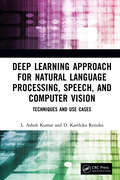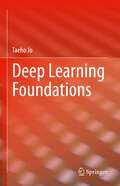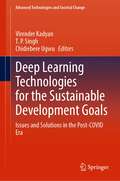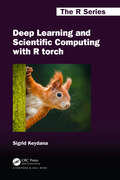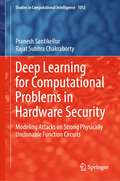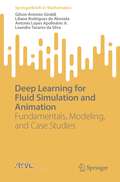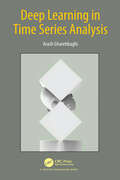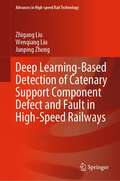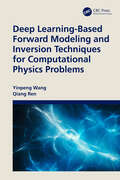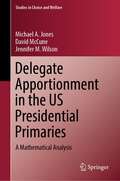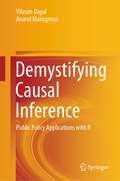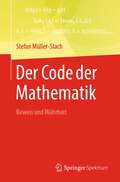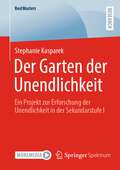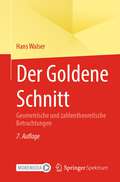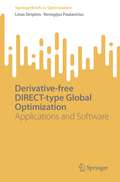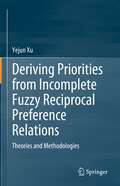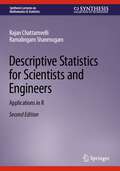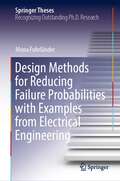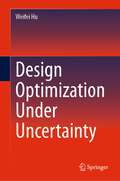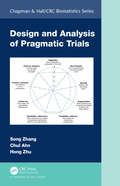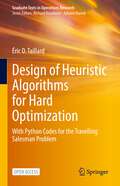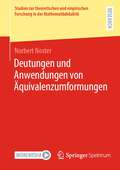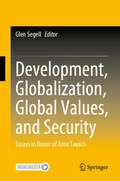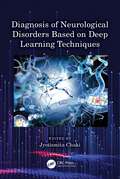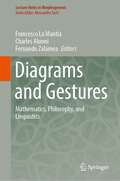- Table View
- List View
Deep Learning Approach for Natural Language Processing, Speech, and Computer Vision: Techniques and Use Cases
by L. Ashok Kumar D. Karthika RenukaDeep Learning Approach for Natural Language Processing, Speech, and Computer Vision provides an overview of general deep learning methodology and its applications of natural language processing (NLP), speech, and computer vision tasks. It simplifies and presents the concepts of deep learning in a comprehensive manner, with suitable, full-fledged examples of deep learning models, with an aim to bridge the gap between the theoretical and the applications using case studies with code, experiments, and supporting analysis. Features: Covers latest developments in deep learning techniques as applied to audio analysis, computer vision, and natural language processing. Introduces contemporary applications of deep learning techniques as applied to audio, textual, and visual processing. Discovers deep learning frameworks and libraries for NLP, speech, and computer vision in Python. Gives insights into using the tools and libraries in Python for real-world applications. Provides easily accessible tutorials and real-world case studies with code to provide hands-on experience. This book is aimed at researchers and graduate students in computer engineering, image, speech, and text processing.
Deep Learning Foundations
by Taeho JoThis book provides a conceptual understanding of deep learning algorithms. The book consists of the four parts: foundations, deep machine learning, deep neural networks, and textual deep learning. The first part provides traditional supervised learning, traditional unsupervised learning, and ensemble learning, as the preparation for studying deep learning algorithms. The second part deals with modification of existing machine learning algorithms into deep learning algorithms. The book’s third part deals with deep neural networks, such as Multiple Perceptron, Recurrent Networks, Restricted Boltzmann Machine, and Convolutionary Neural Networks. The last part provides deep learning techniques that are specialized for text mining tasks. The book is relevant for researchers, academics, students, and professionals in machine learning.
Deep Learning Technologies for the Sustainable Development Goals: Issues and Solutions in the Post-COVID Era (Advanced Technologies and Societal Change)
by T. P. Singh Virender Kadyan Chidiebere UgwuThis book provides insights into deep learning techniques that impact the implementation strategies toward achieving the Sustainable Development Goals (SDGs) laid down by the United Nations for its 2030 agenda, elaborating on the promises, limits, and the new challenges. It also covers the challenges, hurdles, and opportunities in various applications of deep learning for the SDGs. A comprehensive survey on the major applications and research, based on deep learning techniques focused on SDGs through speech and image processing, IoT, security, AR-VR, formal methods, and blockchain, is a feature of this book. In particular, there is a need to extend research into deep learning and its broader application to many sectors and to assess its impact on achieving the SDGs. The chapters in this book help in finding the use of deep learning across all sections of SDGs. The rapid development of deep learning needs to be supported by the organizational insight and oversight necessary for AI-based technologies in general; hence, this book presents and discusses the implications of how deep learning enables the delivery agenda for sustainable development.
Deep Learning and Scientific Computing with R torch (Chapman & Hall/CRC The R Series)
by Sigrid Keydanatorch is an R port of PyTorch, one of the two most-employed deep learning frameworks in industry and research. It is also an excellent tool to use in scientific computations. It is written entirely in R and C/C++. Though still "young" as a project, R torch already has a vibrant community of users and developers. Experience shows that torch users come from a broad range of different backgrounds. This book aims to be useful to (almost) everyone. Globally speaking, its purposes are threefold: - Provide a thorough introduction to torch basics – both by carefully explaining underlying concepts and ideas, and showing enough examples for the reader to become "fluent" in torch. - Again with a focus on conceptual explanation, show how to use torch in deep-learning applications, ranging from image recognition over time series prediction to audio classification. - Provide a concepts-first, reader-friendly introduction to selected scientific-computation topics (namely, matrix computations, the Discrete Fourier Transform, and wavelets), all accompanied by torch code you can play with. Deep Learning and Scientific Computing with R torch is written with first-hand technical expertise and in an engaging, fun-to-read way.
Deep Learning for Computational Problems in Hardware Security: Modeling Attacks on Strong Physically Unclonable Function Circuits (Studies in Computational Intelligence #1052)
by Rajat Subhra Chakraborty Pranesh SantikellurThe book discusses a broad overview of traditional machine learning methods and state-of-the-art deep learning practices for hardware security applications, in particular the techniques of launching potent "modeling attacks" on Physically Unclonable Function (PUF) circuits, which are promising hardware security primitives. The volume is self-contained and includes a comprehensive background on PUF circuits, and the necessary mathematical foundation of traditional and advanced machine learning techniques such as support vector machines, logistic regression, neural networks, and deep learning. This book can be used as a self-learning resource for researchers and practitioners of hardware security, and will also be suitable for graduate-level courses on hardware security and application of machine learning in hardware security. A stand-out feature of the book is the availability of reference software code and datasets to replicate the experiments described in the book.
Deep Learning for Fluid Simulation and Animation: Fundamentals, Modeling, and Case Studies (SpringerBriefs in Mathematics)
by Gilson Antonio Giraldi Liliane Rodrigues Almeida Antonio Lopes Apolinário Jr. Leandro Tavares SilvaThis book is an introduction to the use of machine learning and data-driven approaches in fluid simulation and animation, as an alternative to traditional modeling techniques based on partial differential equations and numerical methods – and at a lower computational cost.This work starts with a brief review of computability theory, aimed to convince the reader – more specifically, researchers of more traditional areas of mathematical modeling – about the power of neural computing in fluid animations. In these initial chapters, fluid modeling through Navier-Stokes equations and numerical methods are also discussed.The following chapters explore the advantages of the neural networks approach and show the building blocks of neural networks for fluid simulation. They cover aspects related to training data, data augmentation, and testing. The volume completes with two case studies, one involving Lagrangian simulation of fluids using convolutional neural networks and the other using Generative Adversarial Networks (GANs) approaches.
Deep Learning in Time Series Analysis
by Arash GharehbaghiDeep learning is an important element of artificial intelligence, especially in applications such as image classification in which various architectures of neural network, e.g., convolutional neural networks, have yielded reliable results. This book introduces deep learning for time series analysis, particularly for cyclic time series. It elaborates on the methods employed for time series analysis at the deep level of their architectures. Cyclic time series usually have special traits that can be employed for better classification performance. These are addressed in the book. Processing cyclic time series is also covered herein. An important factor in classifying stochastic time series is the structural risk associated with the architecture of classification methods. The book addresses and formulates structural risk, and the learning capacity defined for a classification method. These formulations and the mathematical derivations will help the researchers in understanding the methods and even express their methodologies in an objective mathematical way. The book has been designed as a self-learning textbook for the readers with different backgrounds and understanding levels of machine learning, including students, engineers, researchers, and scientists of this domain. The numerous informative illustrations presented by the book will lead the readers to a deep level of understanding about the deep learning methods for time series analysis.
Deep Learning-Based Detection of Catenary Support Component Defect and Fault in High-Speed Railways (Advances in High-speed Rail Technology)
by Zhigang Liu Wenqiang Liu Junping ZhongThis book focuses on the deep learning technologies and their applications in the catenary detection of high-speed railways. As the only source of power for high-speed trains, the catenary's service performance directly affects the safe operation of high-speed railways. This book systematically shows the latest research results of catenary detection in high-speed railways, especially the detection of catenary support component defect and fault. Some methods or algorithms have been adopted in practical engineering. These methods or algorithms provide important references and help the researcher, scholar, and engineer on pantograph and catenary technology in high-speed railways. Unlike traditional detection methods of catenary support component based on image processing, some advanced methods in the deep learning field, including convolutional neural network, reinforcement learning, generative adversarial network, etc., are adopted and improved in this book. The main contents include the overview of catenary detection of electrified railways, the introduction of some advance of deep learning theories, catenary support components and their characteristics in high-speed railways, the image reprocessing of catenary support components, the positioning of catenary support components, the detection of defect and fault, the detection based on 3D point cloud, etc.
Deep Learning-Based Forward Modeling and Inversion Techniques for Computational Physics Problems
by Qiang Ren Yinpeng WangThis book investigates in detail the emerging deep learning (DL) technique in computational physics, assessing its promising potential to substitute conventional numerical solvers for calculating the fields in real-time. After good training, the proposed architecture can resolve both the forward computing and the inverse retrieve problems.Pursuing a holistic perspective, the book includes the following areas. The first chapter discusses the basic DL frameworks. Then, the steady heat conduction problem is solved by the classical U-net in Chapter 2, involving both the passive and active cases. Afterwards, the sophisticated heat flux on a curved surface is reconstructed by the presented Conv-LSTM, exhibiting high accuracy and efficiency. Additionally, a physics-informed DL structure along with a nonlinear mapping module are employed to obtain the space/temperature/time-related thermal conductivity via the transient temperature in Chapter 4. Finally, in Chapter 5, a series of the latest advanced frameworks and the corresponding physics applications are introduced. As deep learning techniques are experiencing vigorous development in computational physics, more people desire related reading materials. This book is intended for graduate students, professional practitioners, and researchers who are interested in DL for computational physics.
Delegate Apportionment in the US Presidential Primaries: A Mathematical Analysis (Studies in Choice and Welfare)
by Michael A. Jones David McCune Jennifer M. WilsonThis book provides a comprehensive mathematical description and analysis of the delegate allocation processes in the US Democratic and Republican presidential primaries, focusing on the role of apportionment methods and the effect of thresholds—the minimum levels of support required to receive delegates. The analysis involves a variety of techniques, including theoretical arguments, simplicial geometry, Monte Carlo simulation, and examination of presidential primary data from 2004 to 2020. The book is divided into two parts: Part I defines the classical apportionment problem and explains how the implementation and goals of delegate apportionment differ from those of apportionment for state representation in the US House of Representatives and for party representation in legislatures based on proportional representation. The authors then describe how delegates are assigned to states and congressional districts and formally define the delegate apportionment methods used in each state by the two major parties to allocate delegates to presidential candidates. Part II analyzes and compares the apportionment methods introduced in Part I based on their level of bias and adherence to various notions of proportionality. It explores how often the methods satisfy the quota condition and quantifies their biases in favor or against the strongest and weakest candidates. Because the methods are quota-based, they are susceptible to classical paradoxes like the Alabama and population paradoxes. They also suffer from other paradoxes that are more relevant in the context of delegate apportionment such as the elimination and aggregation paradoxes. The book evaluates the extent to which each method is susceptible to each paradox. Finally, it discusses the appointment of delegates based on divisor methods and notions of regressive proportionality.This book appeals to scholars and students interested in mathematical economics and political science, with an emphasis on apportionment and social choice theory.
Demystifying Causal Inference: Public Policy Applications with R
by Vikram Dayal Anand MurugesanThis book provides an accessible introduction to causal inference and data analysis with R, specifically for a public policy audience. It aims to demystify these topics by presenting them through practical policy examples from a range of disciplines. It provides a hands-on approach to working with data in R using the popular tidyverse package. High quality R packages for specific causal inference techniques like ggdag, Matching, rdrobust, dosearch etc. are used in the book.The book is in two parts. The first part begins with a detailed narrative about John Snow’s heroic investigations into the cause of cholera. The chapters that follow cover basic elements of R, regression, and an introduction to causality using the potential outcomes framework and causal graphs. The second part covers specific causal inference methods, including experiments, matching, panel data, difference-in-differences, regression discontinuity design, instrumental variables and meta-analysis, with the help of empirical case studies of policy issues. The book adopts a layered approach that makes it accessible and intuitive, using helpful concepts, applications, simulation, and data graphs. Many public policy questions are inherently causal, such as the effect of a policy on a particular outcome. Hence, the book would not only be of interest to students in public policy and executive education, but also to anyone interested in analysing data for application to public policy.
Der Code der Mathematik: Beweis und Wahrheit
by Stefan Müller-StachMotiviert durch aktuelle Entwicklungen in der abhängigen Typentheorie und bei Unendlichkategorien präsentiert dieses Buch die Ideengeschichte der Begriffe Wahrheit, Beweis, Gleichheit und Äquivalenz. Neben ausgewählten Ideen von Platon, Aristoteles, Leibniz, Kant, Frege und anderen werden Resultate von Gödel und Tarski über Unvollständigkeit, Unentscheidbarkeit und Wahrheit in deduktiven Systemen und ihren semantischen Modellen vorgestellt. Der Hauptgegenstand dieses Textes ist die abhängige Typentheorie und neuere Entwicklungen in der Homotopy Type Theory. Diese Theorien beinhalten Identitätstypen, die neue Möglichkeiten für Gleichheit, Symmetrie, Äquivalenz und Isomorphie auf konzeptuelle Weise eröffnen. Die Interaktion von Typentheorie und Unendlichkategorien ist ein neues Paradigma für eine strukturelle Sichtweise auf die Mathematik. Sie fördert auch den neuen Trend zur Formalisierung von Mathematik in Form von Beweisassistenten.
Der Garten der Unendlichkeit: Ein Projekt zur Erforschung der Unendlichkeit in der Sekundarstufe I (BestMasters)
by Stephanie KasparekStephanie Kasparek legt in diesem Buch dar, warum der abstrakte mathematische Begriff der Unendlichkeit nicht aus der Schulmathematik ausgeklammert werden soll und verbindet diese Forderung mit dem Vorschlag, erzählend Mathematik zu betreiben: Eine mathematische Reise führt die Schüler*innen zu einem geheimnisvollen Ort, dem Garten der Unendlichkeit, in dem zunächst die Protagonisten Alin und Samy - und mit ihnen die ganze Klasse - dem Zauber der Unendlichkeit nachspüren werden. Die Arbeit umfasst eine fachliche Vertiefung des mathematischen Begriffs der Unendlichkeit, die fachdidaktische Diskussion über den Nutzen einer Auseinandersetzung damit in der Sekundarstufe I sowie die Planung der Unterrichtsreihe, eine Analyse der zwei durchgeführten Erprobungen und das Unterrichtsmaterial inklusive der Erzählung.
Der Goldene Schnitt: Geometrische und zahlentheoretische Betrachtungen
by Hans WalserDieses Buch veranschaulicht zentrale mathematische Aspekte des Goldenen Schnittes: Es geht insbesondere auf geometrische und zahlentheoretische Zusammenhänge und Beispiele ein und macht weiterführende Betrachtungen und Verallgemeinerungen zugänglich.Das Buch richtet sich primär an Studierende, Schülerinnen und Schüler, Mathematiklehrpersonen und interessierte Laien. Es ist modular aufgebaut, so dass die einzelnen Kapitel unabhängig voneinander lesbar sind. Die Lektüre soll zu eigenen geometrischen Aktivitäten anregen. Dazu werden auch Tipps und Verfahrenshinweise aus dem handwerklich-kreativen Bereich gegeben.Ergänzende Animationen sind mit der SN More Media App abrufbar: einfach die SN More Media App kostenfrei herunterladen, ein Bild oder einen Link mit dem Play-Button scannen und sofort die Animation auf Smartphone oder Tablet ausspielen.
Derivative-free DIRECT-type Global Optimization: Applications and Software (SpringerBriefs in Optimization)
by Remigijus Paulavičius Linas StripinisAfter providing an in-depth introduction to derivative-free global optimization with various constraints, this book presents new original results from well-known experts on the subject. A primary focus of this book is the well-known class of deterministic DIRECT (DIviding RECTangle)-type algorithms. This book describes a new set of algorithms derived from newly developed partitioning, sampling, and selection approaches in the box- and generally-constrained global optimization, including extensions to multi-objective optimization. DIRECT-type optimization algorithms are discussed in terms of fundamental principles, potential, and boundaries of their applicability. The algorithms are analyzed from various perspectives to offer insight into their main features. This explains how and why they are effective at solving optimization problems. As part of this book, the authors also present several techniques for accelerating the DIRECT-type algorithms through parallelization and implementing efficient data structures by revealing the pros and cons of the design challenges involved. A collection of DIRECT-type algorithms described and analyzed in this book is available in DIRECTGO, a MATLAB toolbox on GitHub. Lastly, the authors demonstrate the performance of the algorithms for solving a wide range of global optimization problems with various constraints ranging from a few to hundreds of variables.Additionally, well-known practical problems from the literature are used to demonstrate the effectiveness of the developed algorithms. It is evident from these numerical results that the newly developed approaches are capable of solving problems with a wide variety of structures and complexity levels.Since implementations of the algorithms are publicly available, this monograph is full of examples showing how to use them and how to choose the most efficient ones, depending on the nature of the problem being solved. Therefore, many specialists, students, researchers, engineers, economists, computer scientists, operations researchers, and others will find this book interesting and helpful.
Deriving Priorities from Incomplete Fuzzy Reciprocal Preference Relations: Theories and Methodologies
by Yejun XuAs we know, multiplicative preference relations (or called pairwise comparisons in AHP) were proposed by Dr. Thomas L Saaty. One important work is to derive its priority from pairwise comparisons. It has been proposed many methods to derive priority for multiplicative preference relation. On the basis of fuzzy sets, the fuzzy reciprocal preference relation is proposed and is extended to the incomplete contexts. However, how to derive the priorities from incomplete fuzzy reciprocal preference relations is an interesting and challenging work. This book systematically presents the theories and methodologies for deriving priorities from incomplete fuzzy reciprocal preference relations. This book can be divided into three parts. In the first part, this book introduces the basic concepts of fuzzy reciprocal preference relations and incomplete fuzzy reciprocal preference relations. Then, two consistencies of complete fuzzy reciprocal preference relations are introduced: additive consistency and multiplicative consistency. Then, the relationships between the fuzzy reciprocal elements and the weights are showed. Afterward, in the second part, different priority methods are presented. The inconsistency repairing procedures are also proposed. Last, the priority method for incomplete hesitant fuzzy reciprocal preference relations is presented. This book can be used as a reference for researchers in the areas of management science, information science, systems engineering, operations research, and other relevant fields. It can also be employed as a textbook for upper-level undergraduate students and graduate students.
Descriptive Statistics for Scientists and Engineers: Applications in R (Synthesis Lectures on Mathematics & Statistics)
by Ramalingam Shanmugam Rajan ChattamvelliThis book introduces descriptive statistics and covers a broad range of topics of interest to students and researchers in various applied science disciplines. This includes measures of location, spread, skewness, and kurtosis; absolute and relative measures; and classification of spread, skewness, and kurtosis measures, L-moment based measures, van Zwet ordering of kurtosis, and multivariate kurtosis. Several novel topics are discussed including the recursive algorithm for sample variance; simplification of complicated summation expressions; updating formulas for sample geometric, harmonic and weighted means; divide-and-conquer algorithms for sample variance and covariance; L-skewness; spectral kurtosis, etc. A large number of exercises are included in each chapter that are drawn from various engineering fields along with examples that are illustrated using the R programming language. Basic concepts are introduced before moving on to computational aspects. Some applications in bioinformatics, finance, metallurgy, pharmacokinetics (PK), solid mechanics, and signal processing are briefly discussed. Every analyst who works with numeric data will find the discussion very illuminating and easy to follow.
Design Methods for Reducing Failure Probabilities with Examples from Electrical Engineering (Springer Theses)
by Mona FuhrländerThis book deals with efficient estimation and optimization methods to improve the design of electrotechnical devices under uncertainty. Uncertainties caused by manufacturing imperfections, natural material variations, or unpredictable environmental influences, may lead, in turn, to deviations in operation. This book describes two novel methods for yield (or failure probability) estimation. Both are hybrid methods that combine the accuracy of Monte Carlo with the efficiency of surrogate models. The SC-Hybrid approach uses stochastic collocation and adjoint error indicators. The non-intrusive GPR-Hybrid approach consists of a Gaussian process regression that allows surrogate model updates on the fly. Furthermore, the book proposes an adaptive Newton-Monte-Carlo (Newton-MC) method for efficient yield optimization. In turn, to solve optimization problems with mixed gradient information, two novel Hermite-type optimization methods are described. All the proposed methods have been numerically evaluated on two benchmark problems, such as a rectangular waveguide and a permanent magnet synchronous machine. Results showed that the new methods can significantly reduce the computational effort of yield estimation, and of single- and multi-objective yield optimization under uncertainty. All in all, this book presents novel strategies for quantification of uncertainty and optimization under uncertainty, with practical details to improve the design of electrotechnical devices, yet the methods can be used for any design process affected by uncertainties.
Design Optimization Under Uncertainty
by Weifei HuThis book introduces the fundamentals of probability, statistical, and reliability concepts, the classical methods of uncertainty quantification and analytical reliability analysis, and the state-of-the-art approaches of design optimization under uncertainty (e.g., reliability-based design optimization and robust design optimization). The topics include basic concepts of probability and distributions, uncertainty quantification using probabilistic methods, classical reliability analysis methods, time-variant reliability analysis methods, fundamentals of deterministic design optimization, reliability-based design optimization, robust design optimization, other methods of design optimization under uncertainty, and engineering applications of design optimization under uncertainty.
Design and Analysis of Pragmatic Trials (Chapman & Hall/CRC Biostatistics Series)
by Hong Zhu Song Zhang Chul AhnThis book begins with an introduction of pragmatic cluster randomized trials (PCTs) and reviews various pragmatic issues that need to be addressed by statisticians at the design stage. It discusses the advantages and disadvantages of each type of PCT, and provides sample size formulas, sensitivity analyses, and examples for sample size calculation. The generalized estimating equation (GEE) method will be employed to derive sample size formulas for various types of outcomes from the exponential family, including continuous, binary, and count variables. Experimental designs that have been frequently employed in PCTs will be discussed, including cluster randomized designs, matched-pair cluster randomized design, stratified cluster randomized design, stepped-wedge cluster randomized design, longitudinal cluster randomized design, and crossover cluster randomized design. It demonstrates that the GEE approach is flexible to accommodate pragmatic issues such as hierarchical correlation structures, different missing data patterns, randomly varying cluster sizes, etc. It has been reported that the GEE approach leads to under-estimated variance with limited numbers of clusters. The remedy for this limitation is investigated for the design of PCTs. This book can assist practitioners in the design of PCTs by providing a description of the advantages and disadvantages of various PCTs and sample size formulas that address various pragmatic issues, facilitating the proper implementation of PCTs to improve health care. It can also serve as a textbook for biostatistics students at the graduate level to enhance their knowledge or skill in clinical trial design. Key Features: Discuss the advantages and disadvantages of each type of PCTs, and provide sample size formulas, sensitivity analyses, and examples. Address an unmet need for guidance books on sample size calculations for PCTs; A wide variety of experimental designs adopted by PCTs are covered; The sample size solutions can be readily implemented due to the accommodation of common pragmatic issues encountered in real-world practice; Useful to both academic and industrial biostatisticians involved in clinical trial design; Can be used as a textbook for graduate students majoring in statistics and biostatistics.
Design of Heuristic Algorithms for Hard Optimization: With Python Codes for the Travelling Salesman Problem (Graduate Texts in Operations Research)
by Éric D. TaillardThis open access book demonstrates all the steps required to design heuristic algorithms for difficult optimization. The classic problem of the travelling salesman is used as a common thread to illustrate all the techniques discussed. This problem is ideal for introducing readers to the subject because it is very intuitive and its solutions can be graphically represented. The book features a wealth of illustrations that allow the concepts to be understood at a glance. The book approaches the main metaheuristics from a new angle, deconstructing them into a few key concepts presented in separate chapters: construction, improvement, decomposition, randomization and learning methods. Each metaheuristic can then be presented in simplified form as a combination of these concepts. This approach avoids giving the impression that metaheuristics is a non-formal discipline, a kind of cloud sculpture. Moreover, it provides concrete applications of the travelling salesman problem, which illustrate in just a few lines of code how to design a new heuristic and remove all ambiguities left by a general framework. Two chapters reviewing the basics of combinatorial optimization and complexity theory make the book self-contained. As such, even readers with a very limited background in the field will be able to follow all the content.
Deutungen und Anwendungen von Äquivalenzumformungen (Studien zur theoretischen und empirischen Forschung in der Mathematikdidaktik)
by Norbert NosterIm Zentrum der Arbeit steht der Begriff der Äquivalenzumformung, welcher zunächst im Rahmen des Lösens von Gleichungen und anschließend eigenständig diskutiert wird. Diese Diskussion wird um die Einbeziehung sprachwissenschaftlicher Ansätze erweitert, wodurch das Individuum durch Fragen nach der mentalen Repräsentation bzw. Deutung sowie der Anwendung von Äquivalenzumformung in unterschiedlichen Kontexten in den Vordergrund rückt. Zur Untersuchung der Fragen wurde ein Instrument entwickelt, das an einer Stichprobe von 271 Schülerinnen und Schüler (Realschule & Gymnasium) der Jahrgangsstufen neun und zehn eingesetzt wurde. Hierbei werden mittels qualitativer Inhaltsanalyse verschiedene Deutungen identifiziert, die auf unterschiedliche Umformungsregeln hinweisen und zum Teil mit Leistungsunterschieden einhergehen. Darüber hinaus wird gezeigt, dass sich Lösen, Normieren sowie Umstellen von Gleichungen als Anwendungen von Äquivalenzumformungen mittels konfirmatorischer Faktorenanalyse empirisch trennen lassen.
Development, Globalization, Global Values, and Security: Essays in Honor of Arno Tausch
by Glen SegellThis book, written in honor of Arno Tausch, presents cutting-edge research on globalization, development, and global values. Internationally renowned authors cover topics such as global economic and political cycles, global values, and support for terrorism. Over the last five decades, the Austrian political scientist Arno Tausch was a pioneer in studies on globalization, development and global values. This collection of essays takes up the issues dealt with by Tausch and presents perspectives for the 21st Century. Throughout his work, Tausch applied quantitative methods to study the fundamental issues of the global political economy and the global political system, like dependency, economic and political cycles, and global values, based on a rigorous study of available social scientific data, like the World Values Survey and the Arab Barometer.
Diagnosis of Neurological Disorders Based on Deep Learning Techniques
by Jyotismita ChakiThis book is based on deep learning approaches used for the diagnosis of neurological disorders, including basics of deep learning algorithms using diagrams, data tables, and practical examples, for diagnosis of neurodegenerative and neurodevelopmental disorders. It includes application of feed-forward neural networks, deep generative models, convolutional neural networks, graph convolutional networks, and recurrent neural networks in the field of diagnosis of neurological disorders. Along with this, data preprocessing including scaling, correction, trimming, and normalization is also included. Offers a detailed description of the deep learning approaches used for the diagnosis of neurological disorders. Demonstrates concepts of deep learning algorithms using diagrams, data tables, and examples for the diagnosis of neurodegenerative, neurodevelopmental, and psychiatric disorders. Helps build, train, and deploy different types of deep architectures for diagnosis. Explores data preprocessing techniques involved in diagnosis. Includes real-time case studies and examples. This book is aimed at graduate students and researchers in biomedical imaging and machine learning.
Diagrams and Gestures: Mathematics, Philosophy, and Linguistics (Lecture Notes in Morphogenesis)
by Fernando Zalamea Francesco La Mantia Charles AlunniDrawing a line, and then another, and another. Go back from the lines to the movements they capture and see gestures in them: not spatial displacements, but modes of knowledge that pass through the exercise of the body. Discovering something new in a gesture: the line that contracts into a point or the point that expands into a zone, perhaps sinking into a hole. Thus experiencing a diagram: a becoming other inscribed in the novelty of the gesture and in the changes of the forms it shapes. This and much more is discussed in the essays gathered in Diagrams and Gestures. Resulting from trans-disciplinary work between mathematicians, philosophers, linguists and semioticians, the volume delivers an up-to-date account of the most valuable research on the connections between gesture and diagram. As one of the most important themes in contemporary thought, the study of these connections poses a challenge for the future: to elaborate a theory that is equal to new and stimulating research methodologies. We call this theory a philosophy of diagrammatic gestures.
